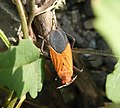| Leptocoris | |
|---|---|
 | |
| Leptocoris rufomarginatus | |
| Scientific classification | |
| Domain: | Eukaryota |
| Kingdom: | Animalia |
| Phylum: | Arthropoda |
| Class: | Insecta |
| Order: | Hemiptera |
| Suborder: | Heteroptera |
| Family: | Rhopalidae |
| Subfamily: | Serinethinae |
| Genus: | Leptocoris Hahn, 1833 |
| Synonyms | |
| |
| External image | |
|---|---|
Leptocoris is the largest genus of bugs in the subfamily Serinethinae. Species in this genus are distributed throughout Africa, South Asia, and Oceania, and are thought to have originated in Africa, where the greatest diversity of Leptocoris species are found. [1] [2] Several species are known as soapberry bugs in Australia, notably Leptocoris mitellatus. [3]



